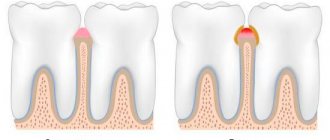Plaque on the tongue of fungal origin - why candidiasis appears and methods of combating it
Fungus on the tongue is not such a rare phenomenon, and the development of such a pathological condition is provoked by yeast fungi of the genus Candida. They are present in the body of any person and do not harm him until a certain point. But as soon as the immune system weakens and fails, the fungus will immediately begin to multiply and ultimately can lead to the development of candidiasis (thrush). Today we’ll talk about what a fungal infection of the tongue is, what symptoms are typical for it, and what treatment methods are used today to get rid of this unpleasant disease.
Candida - what is it?
Candida is a single-celled fungus with over 150 different species. Moreover, only 20 of its varieties are capable of provoking the development of pathological conditions in humans. When penetrating into the oral cavity, yeast fungi can spread to the tonsils, in the presence of carious cavities, penetrate into the dentin, and affect various areas of the mucous membrane.
Candida differs from other types of fungi in that it is not capable of forming mycelium or mycelium. They grow from special bags that are located in cells. Seeping into the tissues of the mucous membrane of the mouth and throat, they quickly destroy it. The enzyme they secrete promotes rapid cell breakdown. As a result, a person experiences soreness, dryness and tingling in the mouth, namely on the tongue.
Causes
The cause of fungus in the mouth is an imbalance of microflora and the pathogenic effect of prevailing conditionally pathogenic yeast fungi. The most common pathogens of the genus Candida are Albicans, krusei C, parapsilosis, tropicalis, pseudotropicalis, lusitaniae, dubliniensis and glabrata.
Infection can occur from the outside - during the passage of the birth canal, through sexual contact, kissing and everyday interactions with a sick person. Chronic microtraumas from the edges of teeth, poor dentures, serious illnesses, reduced immunity (including those caused by AIDS), chaotic use of antibiotics, excessive use of antiseptics, and the virulence of the pathogen also contribute to the penetration and growth of yeast fungi in the mouth.
Causes of pathology
Candida are natural inhabitants of the human body, but under normal conditions they do not manifest themselves in any way. A provoking factor may be a malfunction of internal systems and organs, which leads to a deterioration of the immune system. The active reproduction of these microorganisms becomes a consequence of a chemical imbalance in the body, and as a result, a disease such as candidiasis develops, better known as thrush. The manifestations of this pathological condition are difficult to miss - the tongue becomes covered with a characteristic coating, and an unpleasant burning and tingling sensation is felt in the mouth. To understand what the tongue looks like, take a look at the photo below.
This is what a fungal infection on the tongue looks like
There is a whole list of possible reasons that can provoke unnaturally active proliferation of yeast fungi in the oral cavity:
- deterioration of immunity,
- hormonal imbalances, especially common in pregnant women,
- diabetes, tuberculosis, gastrointestinal problems, HIV infection,
- taking certain medications, including corticosteroids,
- long-term antibiotic therapy,
- deficiency of vitamins B, C, PP,
- dysbacteriosis,
- nicotine addiction, excessive alcohol consumption, drug use,
- radiation as part of the treatment of cancer,
- taking hormonal contraceptives,
- the presence of microtraumas on the mucous membrane or directly on the teeth.
Fungus on the root, back, sides or under the tongue may appear as a result of contact with a disease carrier. For example, a child may receive it from the mother during childbirth. In addition, you can become infected through kissing, sexual intercourse, or sharing personal hygiene items.
General information
Mycosis of the mucous membranes of the oral cavity ( stomatitis or thrush ) is usually a dysbiosis , it is provoked by yeast fungi and most often by the genus Candida. A fungal infection can affect both adults and children, regardless of gender, the main condition is the presence of severe illness or long-term antibiotic therapy, but most often it affects infants or elderly people who have a chronically weakened immune system , the functioning of other systems is not adapted or impaired, and organs.
It can occur as an independent pathology, be a secondary infection or a manifestation of other chronic diseases.
How to recognize a fungus - symptoms of the disease
Currently, experts identify several of the most common types of fungal infections of the tongue, each of which is characterized by its own symptoms. Let's take a closer look at these types:
- pseudomembranous, acute form: most often affects newborns and adults with seriously compromised immunity. A whitish coating appears on all surfaces of the oral cavity, including the cheeks, gums and throat; visually it resembles traces of cottage cheese or milk,
- pseudomembranous chronic: develops in patients with AIDS, as well as against the background of infections that have developed resistance to antibiotics. The symptoms are similar to those described above, the person may also experience pain when swallowing,
- atrophic, acute form: usually develops after prolonged use of antibiotics, often found in diabetics. In this case, swelling of the tongue is observed, the mucous membrane becomes covered with cheesy discharge, the person feels an unpleasant burning sensation, and the corners of the lips dry out and become covered with small cracks,
- atrophic chronic: as practice shows, this form is usually encountered by people with dental prosthetic devices. Active reproduction of microorganisms often begins under the palatal covering of the structure, and a distinctive symptom is the fact that the tongue acquires a rich red tint,
- erythematous: a chronic form, which is characterized by inflammation of the entire oral mucosa, including the throat, as well as the formation of a whitish coating,
- hyperplastic: accompanied by the formation of a dense coating in the form of plaques, but in this case it is not white, but practically merges with the natural shade of the tongue. Slight redness may be detected along the edges.
How to treat the pathology is determined by the attending physician, and before prescribing therapy, he needs to find out what specific form of pathology he is dealing with. To do this, the specialist conducts a visual examination and sends the patient for tests.
Age factors of distribution
Candidiasis on the tongue most often occurs in newborns. Moreover, treating a disease in a child is much simpler and faster than in an adult patient. The younger he is, the easier the disease is to treat.
Most common in childhood
“My daughter, when she was not yet a year old, was diagnosed with candidiasis. I noticed a white coating on my tongue, at first I thought it was a nutritional mixture. I tried to wash it off with water, but nothing happened. The doctor said that there was nothing wrong with it; fungus in the mouth is often found in infants. We were prescribed Fluconozol and a general strengthening multivitamin complex. The plaque disappeared quite quickly, literally within a week, and did not appear again.”
Karina88, Moscow, from correspondence on the woman.ru forum
Quite often, older people have to deal with candidiasis. According to statistics, about 10% of people over 60 years old experience this unpleasant disease1. This trend is primarily associated with wearing prosthetic structures in old age, which often create ideal conditions for the rapid spread of fungus.
In children
In infancy, oral mycosis is usually caused by Oidium albicans and is called thrush. Small children under one year old require special attention, because fungus in the mouth and other mucous membranes of babies can occur as a result of:
- breastfeeding or passing through the birth canal of an infected mother;
- violation of hygiene standards - use of unsterile utensils, things, household items, etc.;
- sexual contact, for example, oral sex;
- excessive consumption of sugars, for example, during artificial feeding.
Despite the fact that thrush in children tends to return, it is easier to tolerate than in adults and can be treated, in more rare cases it can provoke a fungus on the tonsils in a child, enter the body along with food during swallowing and provoke intestinal dysbiosis .
How to deal with the disease - treatment methods
General and local remedies will help cure candidiasis. However, only a doctor can select the appropriate set of medications after diagnosing and identifying the causes of the disease. So, how to get rid of fungus on the tongue? Common treatment methods are discussed below.
General agents
To quickly and reliably remove manifestations of infection in the mouth, drugs are usually prescribed that affect not only the affected area, but the body as a whole, helping to remove infection from the blood. In such situations, antibiotics are often prescribed - Levorin and Nystatin tablets. Already on the fifth day after the start of treatment, the symptoms begin to subside, and a clear decrease in plaque can be noticed.
Medicines will relieve symptoms on the 5th day
In advanced stages, the doctor may suggest Amphotericin (intravenously administered) or a course using Amphoglucamine in tablet form. Additionally, multivitamin complexes and calcium gluconate are prescribed to strengthen the immune system.
Local remedies
Topical medications help relieve visible manifestations of the disease in localized areas. They help relieve redness, eliminate discomfort in the oral cavity, restore the integrity of the mucous membrane and stop the proliferation of pathogenic microorganisms. Often, treatment of the affected areas with Fukortsin and brilliant green is prescribed, or Lizak or Lysozyme are suckable tablets. If pathological processes have affected the lips, levorin or nystatin ointment is recommended.
Important! You can start taking pills and using external products only with the permission of your doctor. Self-medication is strictly prohibited - otherwise, you can cause a sharp deterioration in the condition. The same applies to the use of folk remedies - only after agreement with a specialist.
You will also need to undergo complete sanitation of the oral cavity, which will stop the spread of infection and prevent it from “spreading” to new, untouched tissues.
Treatment of tongue candidiasis
The treatment regimen is selected taking into account the factor that provoked the development of the disease. The main goal of therapy is not just to destroy pathogenic flora, but also to strengthen the immune system and improve the functioning of the stomach and intestines. If this is not done, the likelihood of relapse will remain high.
If the disease is caused by long-term antibiotic therapy, taking hormones or steroids, as is most often the case, you need to reduce the dosage of drugs from these groups and at the same time start using antifungal tablets. B vitamins and immunomodulators have an excellent effect on the body during the treatment of tongue candidiasis.
Medicines used for candidiasis
It is impossible to get rid of fungi of the genus Candida that have multiplied on the mucous membranes of the tongue without medications. Medicines should:
- relieve inflammation;
- activate regeneration processes;
- reduce pain;
- destroy fungi;
- heal ulcers;
- reduce swelling.
For this purpose, dentists prescribe the following pharmacological groups:
- Antifungal. They act by destroying the cell membranes of the pathogen. They are manufactured in the form of tablets and capsules for oral administration.
- Antiseptics for mouth rinsing. They destroy viruses, fungi, bacteria, and create conditions for the restoration of healthy microflora.
- Gels and ointments with antifungal activity. Used strictly locally. They treat the surface of the entire tongue. They help remove swelling, minimize itching and burning. Excellent healing of existing wounds.
- Antiseptics in the form of aerosols. Very convenient to use. Suitable for use in public places. Characterized by a wide spectrum of action.
When treating candidiasis in the tongue, it is important to use exactly the drugs prescribed by the doctor. There is no need to exceed their dosage, as this may cause the opposite effect.
Traditional methods of combating oral candidiasis
If you really want to supplement drug therapy with herbal remedies, it is permissible to use:
- decoctions of anti-inflammatory herbs;
- alcohol tincture of propolis;
- soda solution.
These products should be used while rinsing the mouth.
What is recommended to rinse your mouth with?
As part of the treatment, various rinses are recommended. As a rule, specialists prescribe solutions for disinfection; they help remove plaque, remove secretions from other areas of the mucous membrane, suppress inflammation, and also heal microtraumas on soft tissues. In such situations, a 2% solution of regular baking soda or a mixture of iodinol and water is often used. It is recommended to repeat rinsing every couple of hours, as well as after waking up and before going to bed. On average, the course lasts about 2 weeks. However, therapy should never be started without the consent of a specialist. Before performing the first procedure, consult your doctor.
Rinsing is prescribed by the attending physician
Diet for candidiasis on the tongue
Compliance with certain dietary restrictions is an important point in treatment. For example, experts strongly recommend avoiding products with yeast. Too spicy and sour foods provoke irritation of the oral mucosa, which can cause an unpleasant tingling sensation and even pain. During recovery, doctors advise eating mainly liquid and warm food. In this case, spices and acid-containing foods will have to be excluded for a while.
You need to return to your usual diet gradually. For three months you will have to give up sweet and fatty foods, carbonated water, mushrooms, as well as confectionery and alcoholic drinks.
Preventive measures
After recovery, it is important to take care of preventing relapses. To do this, you need to maintain oral hygiene, brush your teeth at least twice a day with a brush and paste, use special floss to clean the interdental spaces and rinse your mouth with water every time after eating. These are basic rules, the observance of which will significantly reduce the risk of recurrence of candidiasis symptoms. Also, do not forget to renew your toothbrush every 4 months and visit your dentist every six months for preventive examinations. In order to maintain the body's immune strength, doctors advise taking vitamin complexes from time to time, eating more vegetables and fruits, leading a more active lifestyle, and also spending more time in the fresh air.
- Statistics from WHO - World Health Organization.
Prevention
There are a number of preventive measures to prevent the development of fungus in the oral cavity, these include:
- regular visits to the dentist, at least 2 times a year;
- taking medications that strengthen the immune system and following a healthy, nutritious diet;
- compliance with the rules of oral hygiene - cleansing plaque with toothpaste and rinses 2 times a day;
- quitting smoking and alcohol;
- minimal consumption of foods high in sugar and yeast, these include baked goods and other bakery, confectionery products, beer, etc.







